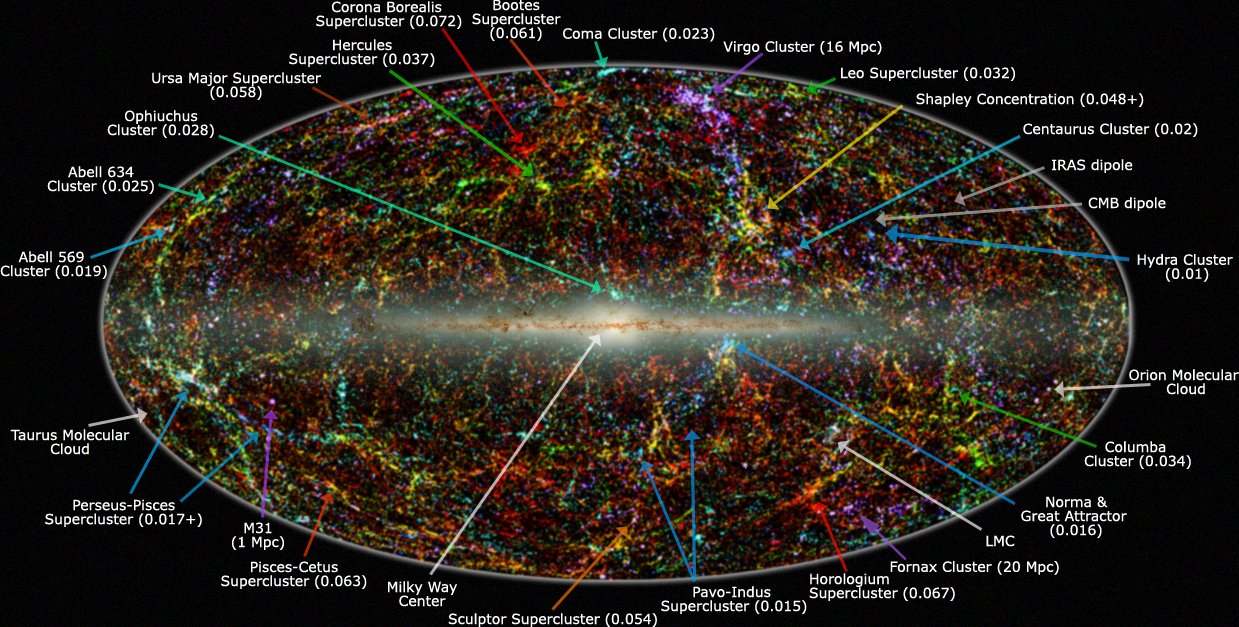Great Attractor: Mysterious Gravitational Anomaly Beyond Hydra-Centaurus Supercluster
A. Sutherland – MessageToEagle.com – In the 1980s, a group of astronomers noticed that galaxies are very unevenly distributed in space, with galactic superclusters separated by incredibly huge voids of visible ordinary matter.
Panoramic view of the entire near-infrared sky. The location of the Great Attractor is shown following the long blue arrow at bottom-right. Thomas Jarrett/IPAC/Caltech
The Great Attractor is a huge and perplexing astrophysical enigma.
It is a gigantic concentration of matter spread over a wide area of about 400 million light-years. It is located approximately 250 million light-years away beyond the Hydra-Centaurus Supercluster at the center of the Laniakea Supercluster (home to the Milky Way and approximately 100,000 other nearby galaxies).
See also:
‘Zone Of Avoidance’ – Hidden Galaxies Behind The Milky Way – Discovered
Boss Great Wall: Gigantic Wall Of Galaxies Located In Deep Space
The Great Attractor is considered to be a gravitational anomaly that reveals the existence of a localized concentration of mass tens of thousands of times more massive than the Milky Way.
Observing the Great Attractor is difficult at optical wavelengths. The plane of the Milky Way — responsible for the numerous bright stars in this image — both outshines (with stars) and obscures (with dust) many of the objects behind it. There are some tricks for seeing through this — infrared or radio observations, for instance — but the region behind the center of the Milky Way, where the dust is thickest, remains an almost complete mystery to astronomers. Image credit: ESA/Hubble/NASA
The anomaly is pulling hundreds of thousands of galaxies, including the Milky Way. This pulling happens at velocities of about 600 to thousands of kilometers (or miles) per second!
It lies in the so-called “Zone of Avoidance“, where the dust and stars of the Milky Way’s disk obscure as much as a quarter of the Earth’s visible sky.
The survey conducted in 2005 confirmed earlier theories that the Milky Way galaxy was, in fact, being pulled towards a much more massive cluster of galaxies near the Shapley Supercluster, which is beyond the Great Attractor.
The Shapley Supercluster (SCl 124) is the largest concentration of galaxies in our nearby universe. It contains more than 8000 galaxies with a total mass of more than ten million billion times the mass of the Sun. It’s the most massive galaxy cluster within a billion light-years, and we and every galaxy in our region of the universe are moving toward it.
Written by – A. Sutherland – MessageToEagle.com Senior Staff Writer
MessageToEagle.com
Expand for referencesRelated Posts
-
 Pulsating Supergiant Betelgeuse That Might Go Supernova
No Comments | Mar 1, 2020
Pulsating Supergiant Betelgeuse That Might Go Supernova
No Comments | Mar 1, 2020 -
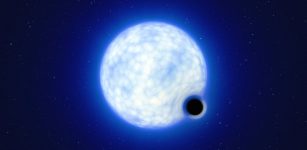 ‘Black Hole Police’ Discover A Dormant Black Hole Outside The Milky Way Galaxy
No Comments | Jul 19, 2022
‘Black Hole Police’ Discover A Dormant Black Hole Outside The Milky Way Galaxy
No Comments | Jul 19, 2022 -
 One Of Most Massive And Dense Super-Earth Planets Discovered In Pisces Constellation
No Comments | Feb 11, 2018
One Of Most Massive And Dense Super-Earth Planets Discovered In Pisces Constellation
No Comments | Feb 11, 2018 -
 Mysterious Gosford Glyphs: Remarkable Ancient Egyptian Hieroglyphs Discovered In Australia Could Re-Write History
No Comments | Feb 20, 2020
Mysterious Gosford Glyphs: Remarkable Ancient Egyptian Hieroglyphs Discovered In Australia Could Re-Write History
No Comments | Feb 20, 2020 -
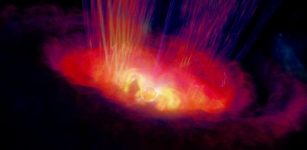 First Observational Evidence of Gamma-Ray Emission In Young Sun-Like Stars
No Comments | Aug 23, 2023
First Observational Evidence of Gamma-Ray Emission In Young Sun-Like Stars
No Comments | Aug 23, 2023 -
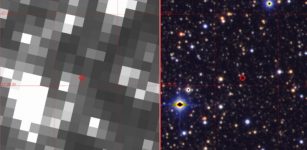 Amazing Discovery: A Near-Identical Jupiter’s Twin Orbiting A Star At Distance Of 17,000 Ligh-Years From Earth
No Comments | Apr 1, 2022
Amazing Discovery: A Near-Identical Jupiter’s Twin Orbiting A Star At Distance Of 17,000 Ligh-Years From Earth
No Comments | Apr 1, 2022 -
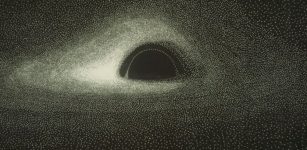 Expansion Of The Universe Directly Impacts Black Hole Growth – New Study
No Comments | Nov 4, 2021
Expansion Of The Universe Directly Impacts Black Hole Growth – New Study
No Comments | Nov 4, 2021 -
 Highest Energy Gamma-Rays Ever From A Pulsar – Discovered
No Comments | Oct 6, 2023
Highest Energy Gamma-Rays Ever From A Pulsar – Discovered
No Comments | Oct 6, 2023 -
 Red Giant Star R Doradus: Stardust Study Resets How Life’s Atoms Spread
No Comments | Jan 7, 2026
Red Giant Star R Doradus: Stardust Study Resets How Life’s Atoms Spread
No Comments | Jan 7, 2026 -
 New Look At Dark Matter – New Candidate May Shed Light
No Comments | Mar 4, 2020
New Look At Dark Matter – New Candidate May Shed Light
No Comments | Mar 4, 2020

